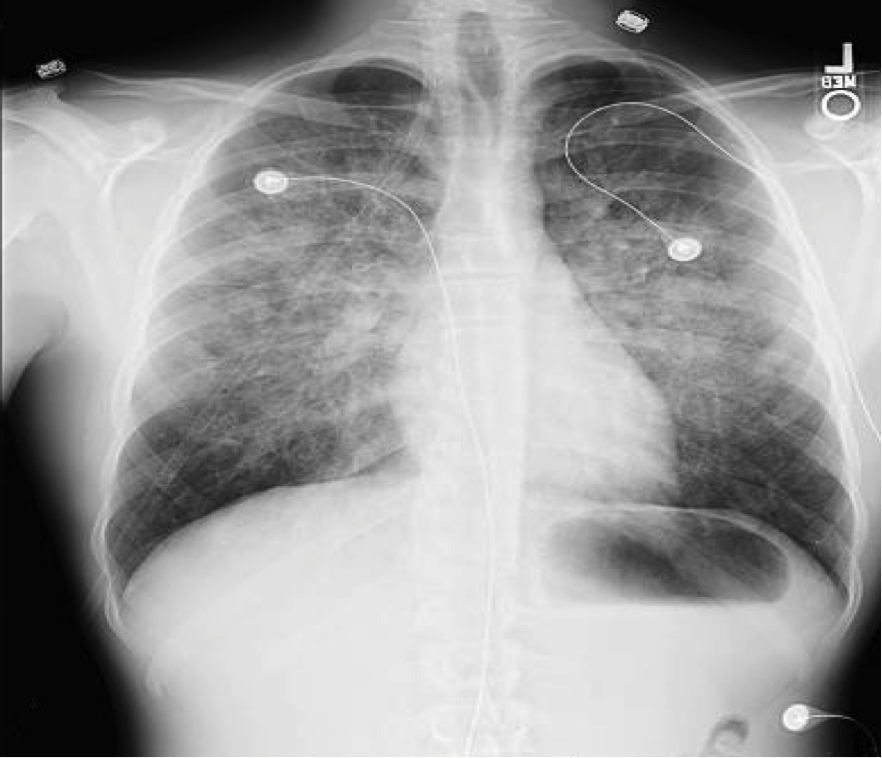WBR0399
Jump to navigation
Jump to search
| Author | PageAuthor::Vendhan Ramanujam |
|---|---|
| Exam Type | ExamType::USMLE Step 2 CK |
| Main Category | MainCategory::Internal medicine |
| Sub Category | SubCategory::Respiratory |
| Prompt | [[Prompt::A 28 year old man is brought to the ER after being found unconscious in a swimming pool. The patient is mildly cyanotic. Blood pressure is 80/50 mm Hg, heart rate is 60 beats/min, and respiratory rate is 26 breaths/min. The patients core body temperature is 32 C. Pupils are 4 mm bilaterally and reactive. The patient is moving all extremities and responds appropriately to questions. Crackles are heard bilaterally on lung auscultation. Pulse oximetry reveals a saturation of 94%. Chest radiograph reveals bilateral perihilar infiltrates with a normal sized heart. Which of the following is the most likely diagnosis?
 |
| Answer A | AnswerA::Aspiration pneumonia |
| Answer A Explanation | [[AnswerAExp::Incorrect-The history and findings are inconsistent with aspiration pneumonia which usually presents with dyspnea, productive cough (greenish or yellow sputum), high grade fever, pleuritic chest pain, rapid and shallow breathing. Chest x-rays may reveal areas of opacity (seen as white) which represent consolidation.]] |
| Answer B | AnswerB::Pulmonary hemorrhage |
| Answer B Explanation | [[AnswerBExp::Incorrect-The history and findings are inconsistent with pulmonary hemorrhage which usually presents with abrupt onset of cough, fever, and dyspnea. Anemia and the presence of hemorrhagic fluid during bronchoscopy will support the diagnosis. The chest radiograph may show new patchy or diffuse alveolar infiltrates.]] |
| Answer C | AnswerC::Congestive heart failure |
| Answer C Explanation | AnswerCExp::'''Incorrect'''-The history and findings are inconsistent with congestive heart failure, which is a cause of cardiogenic pulmonary edema. |
| Answer D | AnswerD::Noncardiogenic pulmonary edema |
| Answer D Explanation | [[AnswerDExp::Correct-Respiratory failure, severe hypothermia, and neurologic injury following near drowning and chest radiography revealing bilateral perihilar infiltrates are consistent with the diagnosis of noncardiogenic pulmonary edema, following near drowning.]] |
| Answer E | AnswerE::Drowning |
| Answer E Explanation | AnswerEExp::'''Incorrect'''-Near drowning and not drowning is the appropriate diagnosis. |
| Right Answer | RightAnswer::D |
| Explanation | [[Explanation::Drowning is death from suffocation after submersion. Fresh water drowning in swimming pools is actually more common than saltwater drowning. The patient described has noncardiogenic pulmonary edema, which is a complication of near drowning (survival after suffocation from submersion). This is a result of direct pulmonary injury, loss of surfactant, and contaminants in the water. Respiratory failure, severe hypothermia, and neurologic injury are the three most common threats to life after submersion.
Educational Objective:
Noncardiogenic pulmonary edema is a complication of near-drowning following direct pulmonary injury, loss of surfactant and contaminants in the water. Respiratory failure, severe hypothermia and neurologic injury are the three most common threats to life after submersion. |
| Approved | Approved::Yes |
| Keyword | |
| Linked Question | Linked:: |
| Order in Linked Questions | LinkedOrder:: |